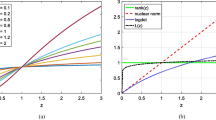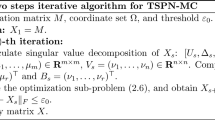Abstract
Recovering the low-rank and sparse components from a given matrix is a challenging problem that has many real applications. This paper proposes a novel algorithm to address this problem by introducing a sparse prior on the low-rank component. Specifically, the low-rank component is assumed to be sparse in a transform domain and a sparse regularizer formulated as an \(\ell _1\)-norm term is employed to promote the sparsity. The truncated nuclear norm is used to model the low-rank prior, rather than the nuclear norm used in most existing methods, to achieve a better approximation to the rank of the considered matrix. Furthermore, an efficient solving method based on a two-stage iterative scheme is developed to address the raised optimization problem. The proposed algorithm is applied to deal with synthetic data and real applications including face image shadow removal and video background subtraction, and the experimental results validate the effectiveness and accuracy of the proposed approach as compared with other methods.






Similar content being viewed by others
Notes
The code of our algorithm is available from https://github.com/xuezc/LRSD-TNNSR.
As the code of LRSD-TNN is not available, we implemented it by ourselves. The codes of IALM and EALM [25] were downloaded from http://perception.csl.illinois.edu/matrix-rank/sample_code.html. The code of FALM [14] is available in the LRSLibrary [40] which can be downloaded from https://github.com/andrewssobral/lrslibrary. The experiments were all performed with MATLAB 2014a in Windows 7 running on an Intel i5-6500 CPU and 8G memory.
The code of noncvxRPCA was downloaded from https://github.com/sckangz/noncvx-PRCA.
The code of incPCP was downloaded from https://sites.google.com/a/istec.net/prodrig/Home/en/pubs/incpcp. The code of GRASTA was downloaded from https://github.com/andrewssobral/lrslibrary. The code of Prac-ReProCS was downloaded from http://www.ece.iastate.edu/~hanguo/PracReProCS.html. We thank the authors of [41] for sharing their code via email.
The BMC Wizard can be downloaded from http://bmc.iut-auvergne.com/.
The results of MOG-RPCA, PCA and DRMF are obtained from [3].
References
Beck, A., Teboulle, M.: A fast iterative shrinkage-thresholding algorithm for linear inverse problems. SIAM J. Imaging Sci. 2(1), 183–202 (2009)
Bhardwaj, A., Raman, S.: Robust PCA-based solution to image composition using augmented lagrange multiplier (ALM). Vis. Comput. 32(5), 591–600 (2016)
Bouwmans, T., Sobral, A., Javed, S., Jung, S.K., Zahzah, E.H.: Decomposition into low-rank plus additive matrices for background/foreground separation: a review for a comparative evaluation with a large-scale dataset. Comput. Sci. Rev. 23, 1–71 (2017)
Bouwmans, T., Zahzah, E.H.: Robust PCA via principal component pursuit: a review for a comparative evaluation in video surveillance. Comput. Vis. Image Underst. 122, 22–34 (2014)
Boyd, S., Parikh, N., Chu, E., Peleato, B., Eckstein, J.: Distributed optimization and statistical learning via the alternating direction method of multipliers. Found. Trends Mach. Learn. 3(1), 1–122 (2011)
Cai, J.F., Candès, E.J., Shen, Z.: A singular value thresholding algorithm for matrix completion. SIAM J. Optim. 20(4), 1956–1982 (2010)
Candès, E.J., Li, X., Ma, Y., Wright, J.: Robust principal component analysis? J. ACM (JACM) 58(3), 11 (2011)
Candès, E.J., Recht, B.: Exact matrix completion via convex optimization. Found. Comput. Math. 9(6), 717 (2009)
Cao, F., Chen, J., Ye, H., Zhao, J., Zhou, Z.: Recovering low-rank and sparse matrix based on the truncated nuclear norm. Neural Netw. 85, 10–20 (2017)
Chandrasekaran, V., Sanghavi, S., Parrilo, P.A., Willsky, A.S.: Rank-sparsity incoherence for matrix decomposition. SIAM J. Optim. 21(2), 572–596 (2011)
Fazel, M.: Matrix rank minimization with applications. Ph.D. thesis, Stanford University (2002)
Fei, L., Xu, Y., Fang, X., Yang, J.: Low rank representation with adaptive distance penalty for semi-supervised subspace classification. Pattern Recognit. 67, 252–262 (2017)
Giraldo-Zuluaga, J.H., Salazar, A., Gomez, A., Diaz-Pulido, A.: Camera-trap images segmentation using multi-layer robust principal component analysis. Vis. Comput. (2017). https://doi.org/10.1007/s00371-017-1463-9
Goldfarb, D., Ma, S., Scheinberg, K.: Fast alternating linearization methods for minimizing the sum of two convex functions. Math. Program. 141(1–2), 349–382 (2013)
Grant, M., Boyd, S.: CVX: Matlab software for disciplined convex programming, version 1.21. Glob. Optim. pp. 155–210 (2008)
Guo, H., Qiu, C., Vaswani, N.: Practical ReProCS for separating sparse and lowdimensional signal sequences from their sum. Preprint (2013)
He, J., Balzano, L., Szlam, A.: Incremental gradient on the Grassmannian for online foreground and background separation in subsampled video. In: Computer Vision and Pattern Recognition (CVPR), 2012 IEEE Conference on, pp. 1568–1575. IEEE (2012)
Hu, Y., Zhang, D., Ye, J., Li, X., He, X.: Fast and accurate matrix completion via truncated nuclear norm regularization. IEEE Trans. Pattern Anal. Mach. Intell. 35(9), 2117–2130 (2013)
Javed, S., Bouwmans, T., Jung, S.K.: Combining ARF and OR-PCA for robust background subtraction of noisy videos. In: International Conference on Image Analysis and Processing, pp. 340–351. Springer (2015)
Javed, S., Mahmood, A., Bouwmans, T., Jung, S.K.: Spatiotemporal low-rank modeling for complex scene background initialization. IEEE Trans. Circuits Syst. Video Technol. pp(99), 1–1 (2016)
Javed, S., Mahmood, A., Bouwmans, T., Jung, S.K.: Background-foreground modeling based on spatiotemporal sparse subspace clustering. IEEE Trans. Image Process. 26(12), 5840–5854 (2017)
Kang, Z., Peng, C., Cheng, Q.: Robust PCA via nonconvex rank approximation. In: Data Mining (ICDM), 2015 IEEE International Conference on pp. 211–220. IEEE (2015)
Lee, K.C., Ho, J., Kriegman, D.J.: Acquiring linear subspaces for face recognition under variable lighting. IEEE Trans. Pattern Anal. Mach. Intell. 27(5), 684–698 (2005)
Li, L., Huang, W., Gu, I.Y.H., Tian, Q.: Statistical modeling of complex backgrounds for foreground object detection. IEEE Trans. Image Process. 13(11), 1459–1472 (2004)
Lin, Z., Chen, M., Ma, Y.: The Augmented Lagrange Multiplier Method for Exact Recovery Of Corrupted Low-Rank Matrices. arXiv preprint arXiv:1009.5055 (2010)
Lin, Z., Ganesh, A., Wright, J., Wu, L., Chen, M., Ma, Y.: Fast convex optimization algorithms for exact recovery of a corrupted low-rank matrix. Comput. Adv. Multi Sens. Adapt. Process. (CAMSAP) 61(6) (2009)
Liu, Y., Cao, L., Liu, C., Pu, Y., Cheng, H.: Recovering shape and motion by a dynamic system for low-rank matrix approximation in l1 norm. Vis. Comput. Int. J. Comput. Graph. 29(5), 421–431 (2013)
Liu, Y., Jiao, L., Shang, F., Yin, F., Liu, F.: An efficient matrix bi-factorization alternative optimization method for low-rank matrix recovery and completion. Neural Netw. 48, 8–18 (2013)
Luan, X., Fang, B., Liu, L., Yang, W., Qian, J.: Extracting sparse error of robust PCA for face recognition in the presence of varying illumination and occlusion. Pattern Recognit. 47(2), 495–508 (2014)
Mansour, H., Jiang, X.: A robust online subspace estimation and tracking algorithm. In: Acoustics, Speech and Signal Processing (ICASSP), 2015 IEEE International Conference on, pp. 4065–4069. IEEE (2015)
Merhav, N., Kresch, R.: Approximate convolution using DCT coefficient multipliers. IEEE Trans. Circuits Syst. Video Technol. 8(4), 378–385 (1998)
Mu, Y., Dong, J., Yuan, X., Yan, S.: Accelerated low-rank visual recovery by random projection. In: Computer Vision and Pattern Recognition (CVPR), 2011 IEEE Conference on, pp. 2609–2616. IEEE (2011)
Oliver, N., Rosario, B., Pentland, A.: A bayesian computer vision system for modeling human interactions. In: International Conference on Computer Vision Systems, pp. 255–272. Springer (1999)
Porwik, P., Lisowska, A.: The Haar-wavelet transform in digital image processing: its status and achievements. Mach. Graph. Vis. 13(1/2), 79–98 (2004)
Rahmani, M., Atia, G.K.: High dimensional low rank plus sparse matrix decomposition. IEEE Trans. Signal Process. 65(8), 2004–2019 (2017)
Recht, B., Fazel, M., Parrilo, P.A.: Guaranteed minimum-rank solutions of linear matrix equations via nuclear norm minimization. SIAM Rev. 52(3), 471–501 (2010)
Rodriguez, P., Wohlberg, B.: Incremental principal component pursuit for video background modeling. J. Math. Imaging Vis. 55(1), 1–18 (2016)
Seidel, F., Hage, C., Kleinsteuber, M.: pROST: a smoothed \(\ell _p \) robust online subspace tracking method for background subtraction in video. Mach. Vis. Appl. 25(5), 1227–1240 (2014)
Shan, G.: Color image denoising via monogenic matrix-based sparse representation. Vis. Comput. 2, 1–14 (2017)
Sobral, A., Bouwmans, T., Zahzah, E.H.: LRSLibrary: Low-rank and sparse tools for background modeling and subtraction in videos. In: Robust Low-Rank and Sparse Matrix Decomposition: Applications in Image and Video Processing. CRC Press, Taylor and Francis Group
Sobral, A., Bouwmans, T., ZahZah, E.H.: Double-constrained RPCA based on saliency maps for foreground detection in automated maritime surveillance. In: Advanced Video and Signal Based Surveillance (AVSS), 2015 12th IEEE International Conference on, pp. 1–6. IEEE (2015)
Sobral, A., Vacavant, A.: A comprehensive review of background subtraction algorithms evaluated with synthetic and real videos. Comput. Vis. Image Underst. 122, 4–21 (2014)
Sun, Q., Xiang, S., Ye, J.: Robust principal component analysis via capped norms. In: Proceedings of the 19th ACM SIGKDD International Conference on Knowledge Discovery and Data Mining, pp. 311–319. ACM (2013)
Tütüncü, R.H., Toh, K.C., Todd, M.J.: Solving semidefinite-quadratic-linear programs using SDPT3. Math. Programm. 95(2), 189–217 (2003)
Vacavant, A., Chateau, T., Wilhelm, A., Lequièvre, L.: A benchmark dataset for outdoor foreground/background extraction. In: Asian Conference on Computer Vision, pp. 291–300. Springer (2012)
Vaswani, N., Bouwmans, T., Javed, S., Narayanamurthy, P.: Robust PCA and Robust Subspace Tracking. arXiv preprint arXiv:1711.09492 (2017)
Wright, J., Ganesh, A., Rao, S., Peng, Y., Ma, Y.: Robust principal component analysis: exact recovery of corrupted low-rank matrices via convex optimization. In: Advances in Neural Information Processing Systems, pp. 2080–2088 (2009)
Wright, J., Ma, Y., Mairal, J., Sapiro, G., Huang, T.S., Yan, S.: Sparse representation for computer vision and pattern recognition. Proc. IEEE 98(6), 1031–1044 (2010)
Wright, J., Yang, A.Y., Ganesh, A., Sastry, S.S., Ma, Y.: Robust face recognition via sparse representation. IEEE Trans. Pattern Anal. Mach. Intell. 31(2), 210–227 (2009)
Xiong, L., Chen, X., Schneider, J.: Direct robust matrix factorizatoin for anomaly detection. In: Data Mining (ICDM), 2011 IEEE 11th International Conference on, pp. 844–853. IEEE (2011)
Xu, J., Ithapu, V.K., Mukherjee, L., Rehg, J.M., Singh, V.: GOSUS: Grassmannian online subspace updates with structured-sparsity. In: Computer Vision (ICCV), 2013 IEEE International Conference on, pp. 3376–3383. IEEE (2013)
Yang, J., Wright, J., Huang, T.S., Ma, Y.: Image super-resolution via sparse representation. IEEE Trans. Image Process. 19(11), 2861–2873 (2010)
Yin, W., Osher, S., Goldfarb, D., Darbon, J.: Bregman iterative algorithms for \(\ell _1\)-minimization with applications to compressed sensing. SIAM J. Imaging Sci. 1(1), 143–168 (2008)
Yuan, X., Yang, J.: Sparse and low-rank matrix decomposition via alternating direction methods. preprint 12 (2009)
Zhang, H., Lin, Z., Zhang, C., Gao, J.: Relations among some low-rank subspace recovery models. Neural Comput. 27(9), 1915–1950 (2015)
Zhao, Q., Meng, D., Xu, Z., Zuo, W., Zhang, L.: Robust principal component analysis with complex noise. In: International Conference on Machine Learning, pp. 55–63 (2014)
Zhou, T., Tao, D.: Godec: Randomized low-rank and sparse matrix decomposition in noisy case. In: International Conference on Machine Learning. Omnipress (2011)
Funding
This work was supported by the Natural Science Foundation of the Higher Education Institutions of Jiangsu Province of China (17KJB510025), the Natural Science Foundation of China (41676088) and the Major Basic Research Program for National Security of China (973 Program for National Defence, No. 613317).
Author information
Authors and Affiliations
Corresponding author
Ethics declarations
Conflict of interest
The authors declare that they have no conflict of interest.
Rights and permissions
About this article
Cite this article
Xue, Z., Dong, J., Zhao, Y. et al. Low-rank and sparse matrix decomposition via the truncated nuclear norm and a sparse regularizer. Vis Comput 35, 1549–1566 (2019). https://doi.org/10.1007/s00371-018-1555-1
Published:
Issue Date:
DOI: https://doi.org/10.1007/s00371-018-1555-1




